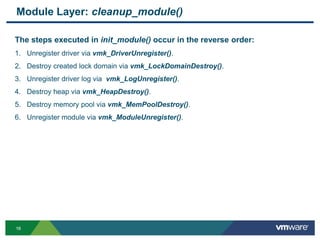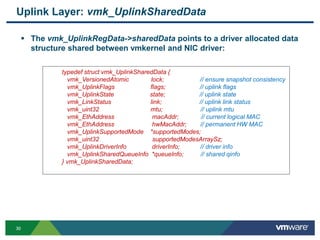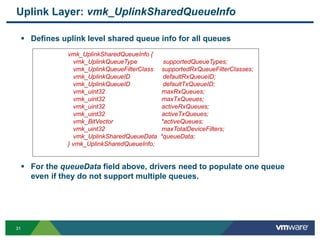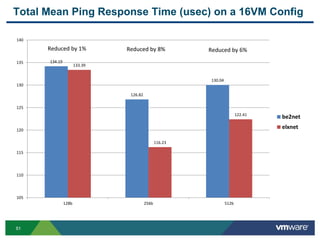Ad
VMworld 2013: ESXi Native Networking Driver Model - Delivering on Simplicity and Performance
- 1. ESXi Native Networking Driver Model - Delivering on Simplicity and Performance Margaret Petrus, VMware TEX4759
- 2. 22 Disclaimer This presentation may contain product features that are currently under development. This overview of new technology represents no commitment from VMware to deliver these features in any generally available product. Features are subject to change, and must not be included in contracts, purchase orders, or sales agreements of any kind. Technical feasibility and market demand will affect final delivery. Pricing and packaging for any new technologies or features discussed or presented have not been determined.
- 3. 33 Key Takeaways 1. The benefits of moving to native driver model with an overview of the different layers. 2. Jumpstart to build your own native driver. 3. The significant CPU savings achieved using the native model, while retaining simplicity and supportability.
- 4. 44 Agenda Overview of Native Model Module Components and Interactions Native Network Driver Deep Dive Building your driver in the native model Advanced Features Performance Summary
- 5. 55 Overview of Native Model
- 6. 66 Why Native Driver Model? Foundation to build new extensible features for ESXi hypervisor Increasing number of VMs in growing cloud deployments demand Device driver robustness Best performance Better supportability, manageability, and debuggability Provide long term binary compatibility support Better flexibility and support to release new features in the networking, storage areas, etc.
- 7. 77 High-level Native Driver Model Overview vmkernel I/O Subsystems Device Manager Device Layer Legend: Physical device Logical device Relationship Device and Driver Objects Drivers
- 8. 88 Module Components and Interactions
- 9. 99 Quick Comparison with VMKLNX Model VM I/O Subsystems vmkplexer vmklinux Linux driver vmKernel Emulated Linux Driver Model VM I/O Subsystems Device Layer Dev Mgr vmKernel Native DriverNative DriverESXi Driver Native Driver Model
- 10. 1010 Device layer PCI Native driver vmkdevmgr IO subsys (scsi, net) vmklinux vmklnx_driver ACPI vmkctl driver.map Layer Interactions in Native Model vs. Vmklinux Model User Level Kernel
- 11. 1111 Native Network Driver Deep Dive
- 12. 1212 Device layer PCI elxnet vmkdevmgr IO subsys (scsi, net) ACPI vmkctl elxnet_devices.py High Level Native Networking Driver Model (using elxnet) Uplink Module elxnet – Emulex Native Driver for BE3 Devices User Level Kernel
- 13. 1313 Native Networking Driver Module Interactions Module layer - Register/Unregister driver with module layer interface • init_module() • cleanup_module() Device Driver layer – Register with device driver interface • Provide vmk_DriverProps and vmk_DriverOps • Callbacks for: DriverAttachDevice(), DriverDetachDevice() DriverScanDevice(), DriverForgetDevice() DriverStartDevice(), DriverQuiesceDevice() PCI layer – Needed for PCI Config access, BAR mapping, SR-IOV, etc. • vmk_PCIReadConfig(), vmk_PCIWriteConfig() • vmk_PCIMapIOResource(), vmk_PCIUnmapIOResource() Uplink layer - Provides the access to the networking stack • Driver has to interact with uplink directly for all operations • Uplink registration results in logical child (vmnicX) creation • Register networking HW capabilities and provide appropriate callbacks Management CLI - Support only via esxcli, not ethtool!
- 15. 1515 Module Layer: init_module() Key steps: 1. Register module with vmkernel via vmk_ModuleRegister(). 2. Initialize driver name via vmk_NameInitialize(). 3. Create heap via vmk_HeapCreate() and memory pool via vmk_MemPoolCreate(). 4. Register for driver logging via vmk_LogRegister(). 5. Create lock domain for the module via vmk_LockDomainCreate(). 6. Register the driver with the driver database via vmk_DriverRegister(). This is where you register the driver properties, i.e. the device layer CB handlers. static vmk_DriverOps elxnetDrvOps = { .attachDevice = elxnet_attachDevice, .detachDevice = elxnet_detachDevice, .scanDevice = elxnet_scanDevice, .startDevice = elxnet_startDevice, .quiesceDevice = elxnet_quiesceDevice, .forgetDevice = elxnet_forgetDevice, }; static vmk_DriverProps elxnetDrvProps = { .ops = &elxnetDrvOps, };
- 16. 1616 Module Layer: cleanup_module() The steps executed in init_module() occur in the reverse order: 1. Unregister driver via vmk_DriverUnregister(). 2. Destroy created lock domain via vmk_LockDomainDestroy(). 3. Unregister driver log via vmk_LogUnregister(). 4. Destroy heap via vmk_HeapDestroy(). 5. Destroy memory pool via vmk_MemPoolDestroy(). 6. Unregister module via vmk_ModuleUnregister().
- 18. 1818 How does Native Driver claim its devices? 1. PCI bus drv scans PCI bus, detects PCI NICs, produces PCI NIC dev object. 2. Device Layer notifies Device Manager of device existence. Device Manager consults the PCI bus plugin to locate the driver 3. NIC Drv registers with Dev layer, providing CBs to claim PCI NIC dev object. 4. Device Manager binds NIC driver module to PCI NIC device object. 5. Device Layer calls NIC driver's AttachDevice callback: NIC driver claims PCI NIC device object NIC driver initializes hardware 6. Device Layer calls NIC driver's StartDevice callback NIC driver leaves quiesced state 7. Device Layer calls NIC driver's ScanDevice callback: NIC driver produces logical uplink device object. 8. Device Layer notifies Device Manager of logical device existence. Device Manager consults the Logical bus plugin to locate the driver Device manager binds the uplink device to the uplink driver attach, start, scan callbacks invoked for uplink device 9. NIC driver registers uplink capabilities in Uplink Registration callback. 10.NIC driver can start RX and networking subsystem can start TX on this NIC.
- 19. 1919 Flow to claim NIC and make it IO-able NIC Driver Networking Subsystem Device Layer vmk_DriverAttachDevice(vmk_PCIDevice) vmk_DriverStartDevice() vmk_DriverScanDevice() vmk_DeviceRegister(vmk_DeviceProps, vmkDev, &uplinkDev) Create and Register uplinkDev vmk_UplinkAssociate() to asynchronously notify uplink for the device vmk_UplinkCapRegister() to register each capability vmk_UplinkStartIO() 1. Arm interrupts in HW 2. Enable interrupts in vmkernel 3. Update uplink link status Uplink is ready for Tx/Rx processing HW initialized for IO
- 20. 2020 Device Layer: DriverAttachDevice() The attachDevice callback registered in vmk_DriverRegister() is invoked. • The driver should start driving this device, get it ready for IO. • If not capable of driving, return error and restore device to original state. What is done in this routine? 1. Allocate memory for driver data structures. 2. Invoke vmk_DeviceGetRegistrationData() to get PCI Device handle. 3. Invoke vmk_PCIQueryDeviceID() to validate driver can support this device. 4. Invoke vmk_PCIQueryDeviceAddr() to get the PCI Device Address. 5. Create the DMA engine via vmk_DMAEngineCreate() with right properties. 6. Map the bars via vmk_PCIMapIOResource() calls. 7. Initialize the HW and ensure that it comes up fine, else error out. 8. Setup stats collections, other driver specific stuff, etc. 9. Allocate interrupt vectors via vmk_PCIAllocIntrCookie() (w/ typeVec, numVec). 10. Create UplinkData – fills up the registration data ops and sharedData fields. 11. Do other controller setup and any other needed configurations. 12. Call vmk_DeviceSetAttachedDriverData() to associate drvPrivDataPtr with vmk_Device handle.
- 21. 2121 Device Layer: DriverStartDevice() Callback after successful attachDevice: Device will not be ready, i.e. not in IO-able state until this callback is done. Puts the device in an IO-able state. Can be invoked to place a device back in an IO-able state any time after vmk_DriverQuiesceDevice() has explicitly put device in quiesced state. What it does? 1. Get drvPrivDataPtr using vmk_DeviceGetAttachedDriverData(). 2. Post rx fragments for all the Rx queues it supports. 3. Register interrupts allocated during uplink shared data creation: • Register interrupts via vmk_IntrRegister(). • Set affinity via vmk_NetPollInterruptSet(). 4. Create any worker threads as worlds via vmk_WorldCreate().
- 22. 2222 Device Layer: DriverScanDevice() Invoked at least once after a device has been attached to a driver. May be invoked at other device hotplug events as appropriate. New devices may be registered from this callback only. Main Steps: 1. Find bus type of the PCI Device via vmk_BusTypeFind(). 2. Create logical address via vmk_LogicalCreateBusAddress(). 3. Register device with vmkernel via vmk_DeviceRegister() passing in the vmk_DeviceProps structure. typedef struct { vmk_Driver registeringDriver; vmk_DeviceID *deviceID; VMK_UPLINK_DEVICE_IDENTIFIER vmk_DeviceOps *deviceOps; has callback .removeDevice vmk_AddrCookie registeringDriverData; holds drvPrivDataPtr vmk_AddrCookie registrationData; } vmk_DeviceProps;
- 23. 2323 Device Layer: DriverForgetDevice() Notification callback from vmkernel To indicate device is no longer accessible Driver no longer to wait indefinitely on any device operation Must always return with success for any subsequent device callbacks vmk_DriverQuiesceDevice() vmk_DriverDetachDevice() Case-specific callback, surprise removal only, not always called
- 24. 2424 Device Layer: DriverQuiesceDevice() Callback places the device in quiesce’d state: Prepare for operations like device removal, driver unload, or system shutdown. This callback indicates that driver should: • Complete any IO on the device • Flush any device caches to quiesce device Steps (reverse of StartDevice): 1. Get drvPrivDataPtr via vmk_DeviceGetAttachedDriverData(). 2. Halt and destroy any worker threads created during StartDevice. 3. Handle all Tx completions. 4. Cleanup all Rx queues. 5. Unregister interrupts for all Rx queues: • Invoke vmk_NetPollInterruptUnSet() to remove affinity. • Invoke vmk_IntrUnregister() to unregister previously registered interrupt.
- 25. 2525 Device Layer: DriverDetachDevice() This is another handler passed in during vmk_DriverRegister() call. • Driver should stop driving this device, and release its resources. • Driver should not touch the device after this. Steps: 1. Get drvPrivDataPtr via vmk_DeviceGetAttachedDriverData(). 2. Cleanup all the resources allocated for your interface: Destroy any queues allocated Notify HW that you are stopping all access 3. Cleanup UplinkData created and setup in DriverAttachDevice(). 4. Release all interrupt vectors via vmk_PCIFreeIntrCookie(). 5. Cleanup any memory allocated for driver structures from memory pool or heap. 6. Any other control path cleanup, i.e. destroy spinlock or semaphores. 7. Unmap BARs via vmk_PCIUnmapIOResource(). 8. Destroy created DMA Engine via vmk_DMAEngineDestroy(). 9. Free up and clean out any other resources allocated.
- 27. 2727 Uplink Layer Major Data Structures vmk_UplinkRegData – uplink registration data Driver responsible for allocating and populating this structure Pointer to this struct is stored in vmk_DeviceProps->registrationData vmk_UplinkOps – handler for basic uplink operations vmk_UplinkSharedData – data shared between uplink layer and NIC driver Allocated and initialized by driver Driver readable and writable Uplink layer readable only vmk_UplinkSharedQueueInfo – shared info for all queues between uplink layer and driver vmk_UplinkSharedQueueData – shared data for a single queue
- 28. 2828 Uplink Layer: vmk_UplinkRegData Driver associates the following registration data to the vmk_Device when creating the logical uplink: typedef struct vmk_UplinkRegData { vmk_revnum apiRevision; // VMKAPI version vmk_ModuleID moduleID; // module ID of NIC drv vmk_UplinkOps ops; vmk_UplinkSharedData *sharedData; // Runtime data shared // b/w kernel & driver vmk_AddrCookie driverData; // Driver context data } vmk_UplinkRegData;
- 29. 2929 Uplink Layer: vmk_UplinkOps Structure containing function pointers for required driver operations. The functions are callbacks from the vmkernel into the NIC driver. typedef struct vmk_UplinkOps { vmk_UplinkTxCB uplinkTx; // Tx packt list CB vmk_UplinkMTUSetCB uplinkMTUSet; // modify MTU CB vmk_UplinkStateSetCB uplinkStateSet; // modify state CB vmk_UplinkStatsGetCB uplinkStatsGet; // get stats CB vmk_UplinkAssociateCB uplinkAssociate; // notify drv about assoc uplink vmk_UplinkDisassociateCB uplinkDisassociate; // notify drv of disassoc uplink vmk_UplinkCapEnableCB uplinkCapEnable; // cap enable CB vmk_UplinkCapDisableCB uplinkCapDisable; // cap disable CB vmk_UplinkStartIOCB uplinkStartIO; // start IO CB vmk_UplinkQuiesceIOCB uplinkQuiesceIO; // queiesce all IO vmk_UplinkResetCB uplinkReset; // reset issued uplink } vmk_UplinkOps;
- 30. 3030 Uplink Layer: vmk_UplinkSharedData The vmk_UplinkRegData->sharedData points to a driver allocated data structure shared between vmkernel and NIC driver: typedef struct vmk_UplinkSharedData { vmk_VersionedAtomic lock; // ensure snapshot consistency vmk_UplinkFlags flags; // uplink flags vmk_UplinkState state; // uplink state vmk_LinkStatus link; // uplink link status vmk_uint32 mtu; // uplink mtu vmk_EthAddress macAddr; // current logical MAC vmk_EthAddress hwMacAddr; // permanent HW MAC vmk_UplinkSupportedMode *supportedModes; vmk_uint32 supportedModesArraySz; vmk_UplinkDriverInfo driverInfo; // driver info vmk_UplinkSharedQueueInfo *queueInfo; // shared qinfo } vmk_UplinkSharedData;
- 31. 3131 Uplink Layer: vmk_UplinkSharedQueueInfo Defines uplink level shared queue info for all queues For the queueData field above, drivers need to populate one queue even if they do not support multiple queues. vmk_UplinkSharedQueueInfo { vmk_UplinkQueueType supportedQueueTypes; vmk_UplinkQueueFilterClass supportedRxQueueFilterClasses; vmk_UplinkQueueID defaultRxQueueID; vmk_UplinkQueueID defaultTxQueueID; vmk_uint32 maxRxQueues; vmk_uint32 maxTxQueues; vmk_uint32 activeRxQueues; vmk_uint32 activeTxQueues; vmk_BitVector *activeQueues; vmk_uint32 maxTotalDeviceFilters; vmk_UplinkSharedQueueData *queueData; } vmk_UplinkSharedQueueInfo;
- 32. 3232 Uplink Layer: vmk_UplinkSharedQueueData Contains all the info about one specific Tx or Rx queue. This struct is shared with uplink layer. typedef struct vmk_UplinkSharedQueueData { volatile vmk_UplinkQueueFlags flags; vmk_UplinkQueueType type; vmk_UplinkQueueID qid; volatile vmk_UplinkQueueState state; vmk_UplinkQueueFeature supportedFeatures; vmk_UplinkQueueFeature activeFeatures; vmk_uint32 maxFilters; vmk_uint32 activeFilters; vmk_NetPoll poll; // associated netPoll context vmk_DMAEngine dmaEngine; // associated dma engine vmk_UplinkQueuePriority priority; // tx queue priority vmk_UplinkCoalesceParams coalesceParams; } vmk_UplinkSharedQueueData;
- 33. 3333 Creation of UplinkSharedData during DriverAttachDevice Create/initialize sharedData area: sharedData has a versioned atomic (not a spinlock) Uplink layer can only read from this area Driver can read/write to this area Driver needs to define its own spinlock for writer serialization Shared Data: 1. Supported speed/duplex modes to be advertised to uplink. 2. Current MTU setting, and link/speed/duplex states. 3. Queue info (numQ, supported queue types, supported filter classes). 4. Rx and Tx queue fields (flags, type, state, supportedFeatures, dmaEngine, maxFilters). 5. netPoll for each Rx queue via vmk_NetPollCreate(). 6. Allocated default Rx and Tx queues (not yet activated).
- 34. 3434 Uplink Layer: uplinkStartIO() Callback 1. Arm the interrupts (link, multiQ, etc) in the HW. 2. Configure for VLAN filtering as needed 3. Change internal driver state to IO-able. 4. Set configured flow control. 5. Now, enable interrupts in vmkernel via vmk_IntrEnable(). 6. Check for link status changes, update sharedData and invoke vmk_UplinkUpdateLinkState() as needed.
- 35. 3535 Uplink Layer: uplinkQuiesceIO() Callback 1. Check if IO is already quiesce’d due to possible failures. 2. Disarm interrupts. 3. Disable netpoll via vmk_NetPollDisable() and vmk_NetPollFlushRx(). 4. Mark link state as down via vmk_UplinkUpdateLinkState(). 5. Stop all Tx queues 6. Sync all vectors via vmk_IntrSync(). 7. Disable all vectors via vmk_IntrDisable(). 8. Change internal driver state to quiesced.
- 36. 3636 Register NIC capabilities to Uplink Layer Handled when uplinkAssociateCB() is invoked to associate uplink with the device. Call vmk_UplinkCapRegister() to register each capability. Two capability types: No callbacks needed: VMK_UPLINK_CAP_IPV4_CSO VMK_UPLINK_CAP_VLAN_RX_STRIP Capabilities that require callbacks: VMK_UPLINK_CAP_MULTI_QUEUE VMK_UPLINK_CAP_COALESCE_PARAMS
- 37. 3737 Callback Ops for VMK_UPLINK_CAP_COALESCE_PARAMS: Callback Ops for VMK_UPLINK_CAP_PRIV_STATS: Examples of Capabilities with Callbacks typedef struct vmk_UplinkCoalesceParamsOps { vmk_UplinkCoalesceParamsGetCB getParams; vmk_UplinkCoalesceParamsSetCB setParams; } vmk_UplinkCoalesceParamsOps; typedef struct vmk_UplinkPrivStatsOps { vmk_UplinkPrivStatsLengthGetCB privStatsLengthGet; vmk_UplinkPrivStatsGetCB privStatsGet; } vmk_UplinkPrivStatsOps;
- 38. 3838 Interrupt/Netpoll Handling Registering interrupts: vmk_IntrProps is populated and passed to vmkernel in DriverStartDevice(). Driver Ack handler: Ack interrupt to HW if needed (INTx) Increment interrupt counter Driver Isr handler: Handle any queue notifications as needed Activate the netpoll for the particular queue via vmk_NetPollActivate() Driver NetPoll Callback Handler: Handle any Tx, Rx, or Ctrl events If there is work but budget exceeded, remain in poll mode & return VMK_TRUE If no more work, go back to interrupt mode and return VMK_FALSE typedef struct vmk_IntrProps { vmk_Device device; vmk_Name deviceName; vmk_IntrAcknowledge acknowledgeInterrupt; driver ack handler vmk_IntrHandler handler; driver isr handler void *handlerData; vmk_uint64 attrs; } vmk_IntrProps;
- 39. 3939 Packet Management VMKAPIs in the Tx/Rx Path Basic allocation, release and field manipulation: • vmk_PktAlloc() • vmk_PktRelease() • vmk_PktReleasePanic • vmk_PktFrameLenGet() • vmk_PktFrameLenSet() • vmk_PktTrim() • vmk_PktPartialCopy() SG Handling: • vmk_PktSgArrayGet() • vmk_PktSgElemGet() • vmk_PktFrameMappedPointerGet() • vmk_PktIsBufDescWritable() Processing the sent down packet list: • vmk_PktListIterStart() • vmk_PktListIterIsAtEnd() • vmk_PktListGetFirstPkt() • vmk_PktListIterInsertPktBefore() • vmk_PktListIterRemovePkt() • vmk_PktListAppendPkt()
- 40. 4040 Packet Management VMKAPIs in the Tx/Rx Path Parse/Find the different layer headers: • vmk_PktHeaderL2Find() • vmk_PktHeaderL3Find() • vmk_PktHeaderEntryGet() • vmk_PktHeaderDataGet() • vmk_PktHeaderDataRelease() • vmk_PktHeaderLength() Offload Handling: • vmk_PktIsMustCsum() • vmk_PktSetCsumVfd() • vmk_PktIsLargeTcpPacket() • vmk_PktGetLargeTcpPacketMss() VLAN Handling: • vmk_PktMustVlanTag() • vmk_PktVlanIDGet() • vmk_PktVlanIDSet() • vmk_PktPriorityGet() • vmk_PktPrioritySet()
- 41. 4141 Advanced Features MultiQueue Handling SR-IOV VXLAN Offload Dynamic Load Balancing
- 42. 4242 Multi-Queue Support Register multi-queue support via VMK_UPLINK_CAP_MULTI_QUEUE Following callbacks passed to uplink when registering this capability typedef struct vmk_UplinkQueueOps { vmk_UplinkQueueAllocCB queueAlloc; vmk_UplinkQueueAllocWithAttrCB queueAllocWithAttr; vmk_UplinkQueueReallocWithAttrCB queueReallocWithAttr; vmk_UplinkQueueFreeCB queueFree; vmk_UplinkQueueQuiesceCB queueQuiesce; vmk_UplinkQueueStartCB queueStart; vmk_UplinkQueueFilterApplyCB queueApplyFilter; vmk_UplinkQueueFilterRemoveCB queueRemoveFilter; vmk_UplinkQueueStatsGetCB queueGetStats; vmk_UplinkQueueFeatureToggleCB queueToggleFeature; vmk_UplinkQueueTxPrioritySetCB queueSetPriority; vmk_UplinkQueueCoalesceParamsSetCB queueSetCoalesceParams; } vmk_UplinkQueueOps;
- 43. 4343 Multi-Queue VMKAPIs in the Tx/Rx path Refer to vmkapi_net_queue.h Main list of APIs for implementing multi-queue support: • vmk_UplinkQueueMkFilterID() • vmk_UplinkQueueMkTxQueueID() • vmk_UplinkQueueMkRxQueueID() • vmk_UplinkQueueIDVal() • vmk_UplinkQueueIDType() • vmk_UplinkQueueFilterIDVal() • vmk_UplinkQueueIDUserVal() • vmk_UplinkQueueSetQueueIDUserVal() • vmk_UplinkQueueIDQueueDataIndex() • vmk_UplinkQueueSetQueueIDQueueDataIndex() • vmk_UplinkQueueGetNumQueuesSupported() • vmk_UplinkQueueStart() • vmk_UplinkQueueStop() • vmk_PktQueueIDGet() • vmk_PktQueueIDSet()
- 44. 4444 SR-IOV Support Setup VFs: • During DriverAttachDevice(), if SR-IOV is supported by device: Enable VFs via vmk_PCIEnableVFs() • During DriverScanDevice(), driver Registers its VFs via vmk_PCIRegisterVF() passing along its .removeVF callback static vmk_PCIVFDeviceOps elxnetVFDevOps = { .removeVF = elxnet_removeVFDevice }; Sets control callback for VF w/ vmkernel via vmk_PCISetVFPrivateData() Cleanup VFs: • The .removeVF callback registered during registration is called: vmk_PCIUnregisterVF() invoked to unregister particular VF from vmkernel • DriverDetachDevice() should call vmk_PCIDisableVFs() to disable all its VFs. Misc VF vmkapi: • vmk_PCIGetVFPCIDevice() should be used during VF registration to get the vmk_PCIDevice handle of a PCI VF given its parent PF and VF index.
- 45. 4545 VXLAN Offload Support Register vxlan offload capability via VMK_UPLINK_CAP_ENCAP_OFFLOAD Callback Ops for VMK_UPLINK_CAP_ENCAP_OFFLOAD: If supporting RX_VXLAN filter, indicate in supportedRxQueueFilterClasses vmk_UplinkSharedQueueInfo->supportedRxQueueFilterClasses |= VMK_UPLINK_QUEUE_FILTER_CLASS_VXLAN; Packet parser APIs to get information on inner encapsulated headers: • vmk_PktHeaderEncapFind() • vmk_PktHeaderEncapL2Find() • vmk_PktHeaderEncapL3Find() • vmk_PktHeaderEncapL4Find() typedef struct vmk_UplinkEncapOffloadOps { /** Handler used by vmkernel to notify VXLAN port number updated */ vmk_UplinkVXLANPortUpdateCB vxlanPortUpdate; } vmk_UplinkEncapOffloadOps;
- 46. 4646 Dynamic Load Balancing New NetQ feature introduced in ESXi 5.5 release: • VMKNETDDI_QUEUEOPS_QUEUE_FEAT_DYNAMIC NIC requirements to support this feature: • Device able to support different NetQ "features" on any particular NetQ • Adding or removing support for a particular NetQ not require any critical operations If NIC driver registers DYNAMIC feature support, load balancer can/will • Move filters between queues (i.e. bin-packing of filters), hence reducing the number of queues in use • Unpack filters to more queues either for latency sensitive VMs, or to reduce burden on over saturated queues
- 47. 4747 Performance
- 48. 4848 Throughput in Gbps on a 16VM Configuration 3.00 2.97 9.40 9.40 3.03 3.02 9.41 9.40 0.000 1.000 2.000 3.000 4.000 5.000 6.000 7.000 8.000 9.000 10.000 Tx Throughput (256B) Rx Throughput (256B) Tx Throughput (64KB) Rx Throughput (64KB) be2net elxnet
- 49. 4949 Overall CPU Gains on a 16VM Configuration 320.89 335.32 29.45 55.40 282.56 307.15 29.34 52.04 0.000 50.000 100.000 150.000 200.000 250.000 300.000 350.000 400.000 Tx CPU Util (256B) Rx CPU Util (256B) Tx CPU Util (64KB) Rx CPU Util (64KB) be2net elxnet 12% Savings 6% Savings8% Savings
- 50. 5050 Vmkernel Cost Savings on a 16VM Configuration 137.92 132.75 8.06 26.17 89.50 96.29 7.03 21.34 0 20 40 60 80 100 120 140 160 Tx CPU Util (256B) Rx CPU Util (256B) Tx CPU Util (64KB) Rx CPU Util (64KB) be2net elxnet 35% Savings 27% Savings 13% Savings 18% Savings
- 51. 5151 Total Mean Ping Response Time (usec) on a 16VM Config 134.19 126.82 130.04 133.39 116.23 122.41 105 110 115 120 125 130 135 140 128b 256b 512b be2net elxnet Reduced by 1% Reduced by 6%Reduced by 8%
- 52. 5252 GettingStartedontheNativeDriver… Go to https://developercenter.vmware.com/group/iovp/certs/5.5/dev-kits for 1. Native DDK Developer Guide 2. Needed toolchain RPMs vmware-esx-common-toolchain vmware-esx-kmdk-psa-toolchain 3. Vib-Suite RPM vmware-esx-vib-suite-5.5.0-0.0.xxxxxxx.i386.rpm 4. Vmkapi DDK RPM: vmware-esx-vmkapiddk-devtools-5.5.0-0.0.xxxxxxx.i386.rpm
- 53. 5353 Summary A layered model approach with easy extensibility for new features Overview of native model Interaction of driver with different layers Basic structs and handlerOps for different layers Native model does not use vmklinux compatability layer A layer of indirection completely removed Translations (eg. pkt<->skb) avoided o Allocation of skbs is not needed o Savings in avoiding slab allocation (esp. at high packet rates) Driver communicates directly with various layers Performance boost in cpu savings New IO features for ESXi will only be developed for native model.
- 54. 5454 Questions? Contact VMware PM for more details of the native model support and for the devkits.
- 55. 5555 Other VMware Activities Related to This Session HOL: HOL-SDC-1302 vSphere Distributed Switch from A to Z
- 56. 5656 • TAP Access membership includes: New TAP Access NFR Bundle • Access to NDA Roadmap sessions at VMworld, PEX and Onsite/Online • VMware Solution Exchange (VSX) and Partner Locator listings • VMware Ready logo (ISVs) • Partner University and other resources in Partner Central • TAP Elite includes all of the above plus: • 5X the number of licenses in the NFR Bundle • Unlimited product technical support • 5 instances of SDK Support • Services Software Solutions Bundle • Annual Fees • TAP Access - $750 • TAP Elite - $7,500 • Send email to [email protected] TAP Membership Renewal – Great Benefits
- 57. 5757 TAP • TAP support: 1-866-524-4966 • Email: [email protected] • Partner Central: http://www.vmware.com/partners/partners.html TAP Team • Kristen Edwards – Sr. Alliance Program Manager • Sheela Toor – Marketing Communication Manager • Michael Thompson – Alliance Web Application Manager • Audra Bowcutt – • Ted Dunn – • Dalene Bishop – Partner Enablement Manager, TAP TAP Resources VMware Solution Exchange • Marketplace support – [email protected] • Partner Marketplace @ VMware booth pod TAP1
- 58. THANK YOU
- 60. ESXi Native Networking Driver Model - Delivering on Simplicity and Performance Margaret Petrus, VMware TEX4759







































































































































































